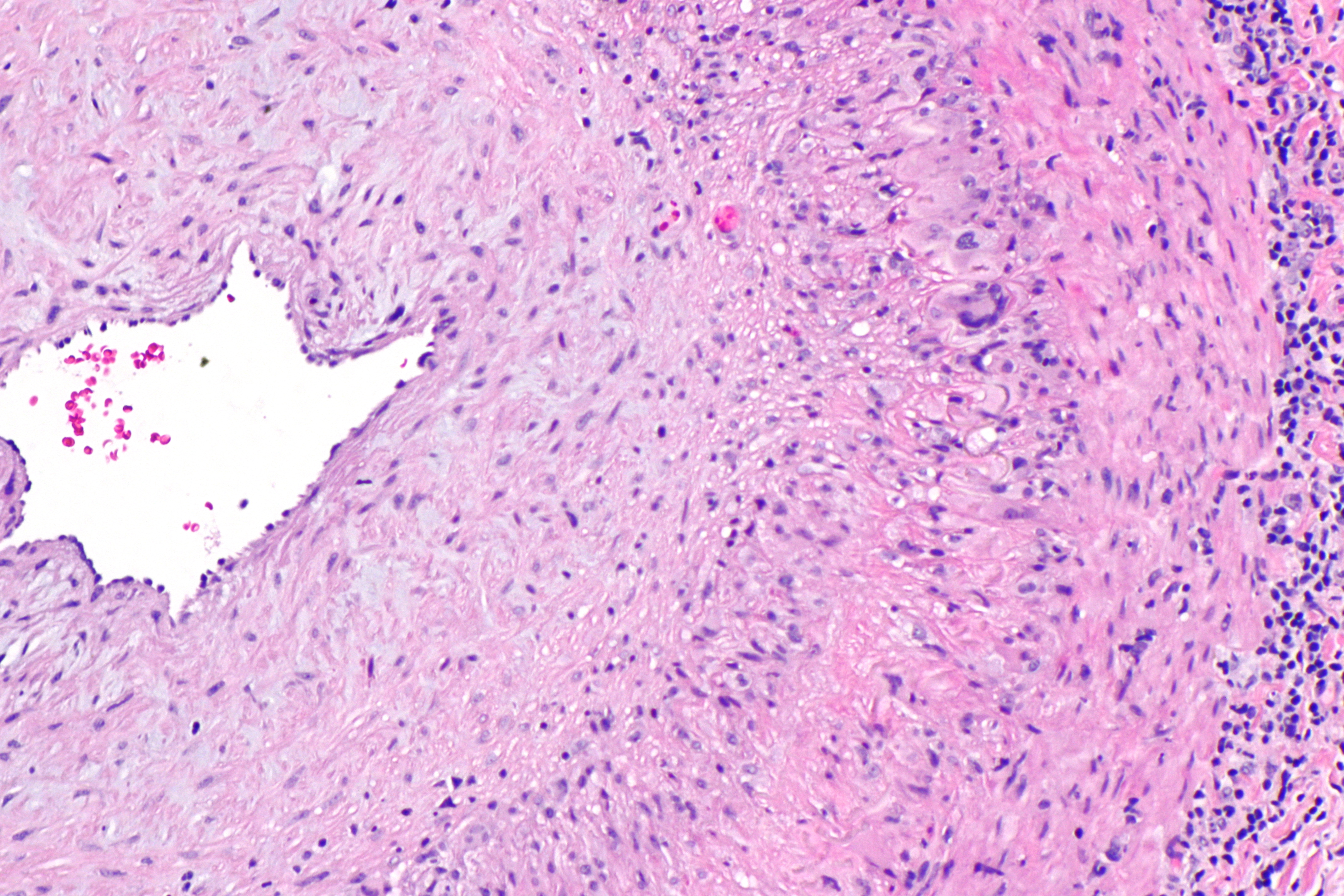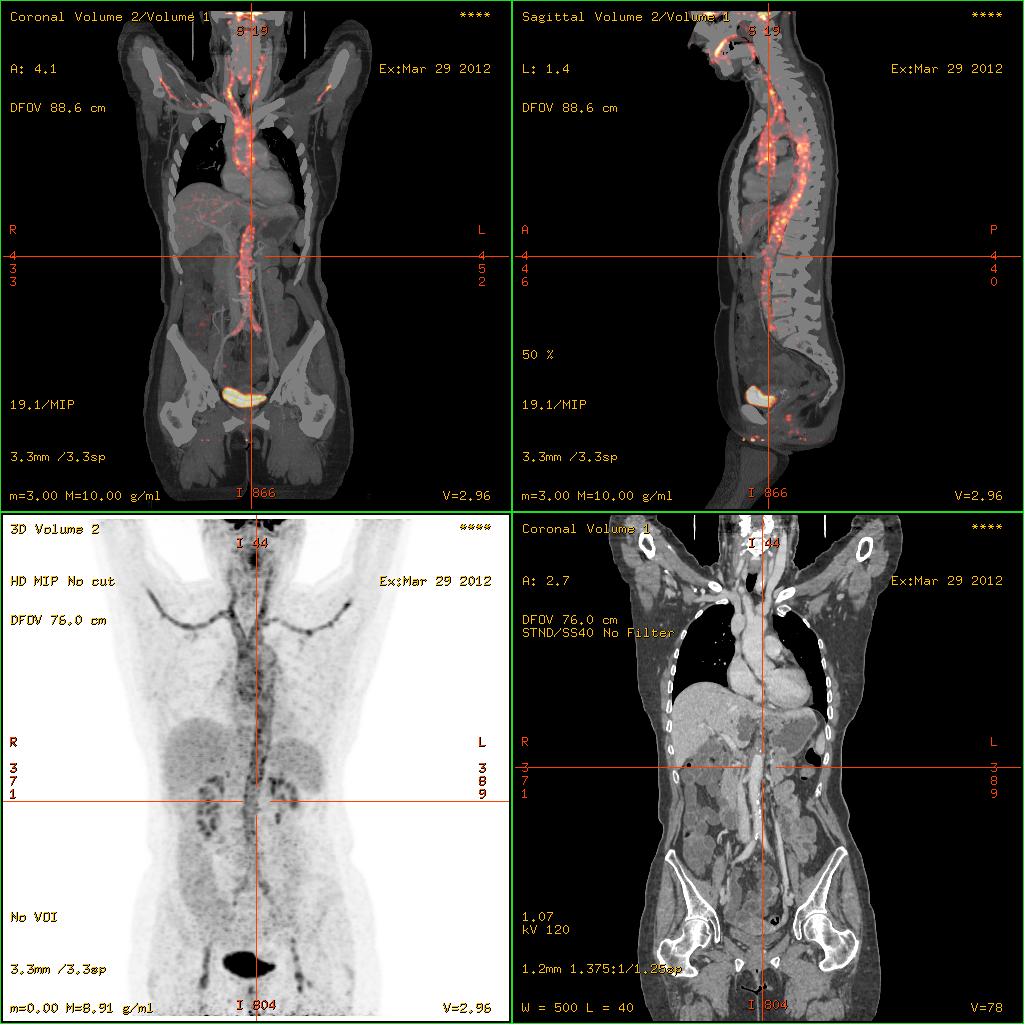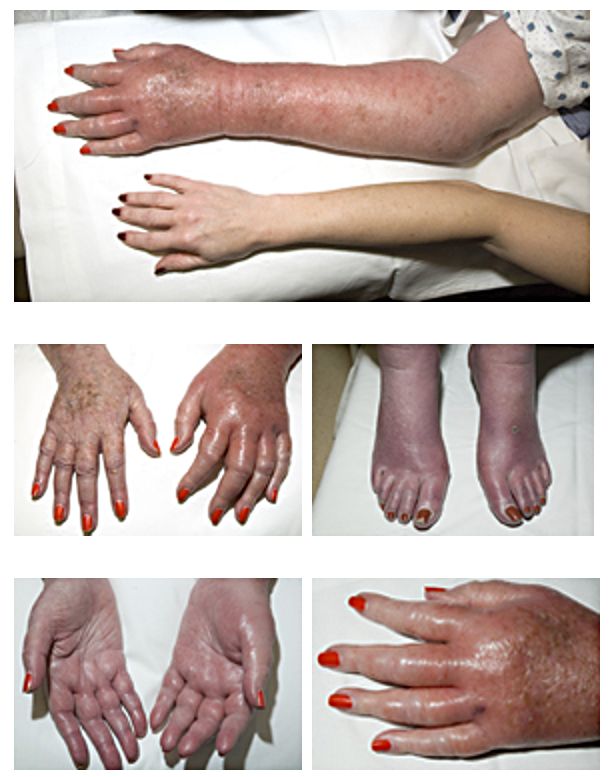|
Arteritis
Arteritis is a vascular disorder characterized by inflammation of the walls of arteries, usually as a result of infection or autoimmune responses. Arteritis, a complex disorder, is still not entirely understood. Arteritis may be distinguished by its different types, based on the organ systems affected by the disease. A complication of arteritis is thrombosis, which can be fatal. Arteritis and phlebitis are forms of vasculitis Vasculitis is a group of disorders that destroy blood vessels by inflammation. Both artery, arteries and veins are affected. Lymphangitis (inflammation of lymphatic vessels) is sometimes considered a type of vasculitis. Vasculitis is primarily c .... Signs and Symptoms Symptoms of general arteritis may include: * Inflammation * Fever * Increased production of red blood cells (erythrocytes) * Limping * Reduced pulse Diagnosis Diagnosis of arteritis is based on unusual medical symptoms. Similar symptoms may be caused by a number of other conditions, su ... [...More Info...] [...Related Items...] OR: [Wikipedia] [Google] [Baidu] |
Giant Cell Arteritis
Giant cell arteritis (GCA), also called temporal arteritis, is an inflammatory autoimmune disease of large blood vessels. Symptoms may include headache, pain over the temples, flu-like symptoms, double vision, and difficulty opening the mouth. Complications can include blockage of the artery to the eye with resulting blindness, as well as aortic dissection, and aortic aneurysm. GCA is frequently associated with polymyalgia rheumatica. The cause is unknown. The underlying mechanism involves inflammation of the small blood vessels that supply the walls of larger arteries. This mainly affects arteries around the head and neck, though some in the chest may also be affected. Diagnosis is suspected based on symptoms, blood tests, and medical imaging, and confirmed by biopsy of the temporal artery. However, in about 10% of people the temporal artery is normal. Treatment is typical with high doses of steroids such as prednisone or prednisolone. Once symptoms have resolved, ... [...More Info...] [...Related Items...] OR: [Wikipedia] [Google] [Baidu] |
Takayasu Arteritis
Takayasu's arteritis (TA), also known as aortic arch syndrome, nonspecific aortoarteritis, and pulseless disease, is a form of large vessel granulomatous vasculitisAmerican College of Physicians (ACP). Medical Knowledge Self-Assessment Program (MKSAP-15): Rheumatology. "Systemic Vasculitis." Pg. 65–67. 2009, ACP. with massive intimal fibrosis and vascular narrowing, most commonly affecting young or middle-aged women of Asian descent, though anyone can be affected. It mainly affects the aorta (the main blood vessel leaving the heart) and its branches, as well as the pulmonary arteries. Females are about 8–9 times more likely to be affected than males. Those with the disease often notice symptoms between 15 and 30 years of age. In the Western world, atherosclerosis is a more frequent cause of obstruction of the aortic arch vessels than Takayasu's arteritis. Takayasu's arteritis is similar to other forms of vasculitis, including giant cell arteritis which typically affects ol ... [...More Info...] [...Related Items...] OR: [Wikipedia] [Google] [Baidu] |
Polyarteritis Nodosa
Polyarteritis nodosa (PAN) is a systemic necrotizing inflammation of blood vessels (vasculitis) affecting medium-sized muscular arteries, typically involving the arteries of the kidneys and other internal organs but generally sparing the lungs' circulation. Small aneurysms are strung like the beads of a rosary, therefore making this "rosary sign" an important diagnostic feature of the vasculitis. PAN is sometimes associated with infection by the hepatitis B or hepatitis C virus. The condition may be present in infants. PAN is a rare disease. With treatment, five-year survival is 80%; without treatment, five-year survival is 13%. Death is often a consequence of kidney failure, myocardial infarction, or stroke. Signs and symptoms PAN may affect nearly every organ system and thus can present with a broad array of signs and symptoms. These manifestations result from ischemic damage to affected organs, often the skin, heart, kidneys, and nervous system. Constitutional symptoms are s ... [...More Info...] [...Related Items...] OR: [Wikipedia] [Google] [Baidu] |
Giant Cell
A giant cell (also known as a multinucleated giant cell, or multinucleate giant cell) is a mass formed by the union of several distinct cells (usually histiocytes), often forming a granuloma. Although there is typically a focus on the pathological aspects of multinucleate giant cells (MGCs), they also play many important physiological roles. Osteoclasts are a type of MGC that are critical for the maintenance, repair, and remodeling of bone and are present normally in a healthy human body. Osteoclasts are frequently classified and discussed separately from other MGCs which are more closely linked with disease. Non-osteoclast MGCs can arise in response to an infection, such as tuberculosis, herpes, or HIV, or as part of a foreign body reaction. These MGCs are cells of monocyte or macrophage lineage fused together. Similar to their monocyte precursors, they can phagocytose foreign materials. However, their large size and extensive membrane ruffling make them better equipped t ... [...More Info...] [...Related Items...] OR: [Wikipedia] [Google] [Baidu] |
Vasculitis
Vasculitis is a group of disorders that destroy blood vessels by inflammation. Both artery, arteries and veins are affected. Lymphangitis (inflammation of lymphatic vessels) is sometimes considered a type of vasculitis. Vasculitis is primarily caused by white blood cell, leukocyte migration and resultant damage. Although both occur in vasculitis, inflammation of veins (phlebitis) or arteries (arteritis) on their own are separate entities. Signs and symptoms The clinical presentation of the various vasculitides on the skin and internal organs is mostly determined by the diameter or size of the vessels mainly affected. Non-specific symptoms are common and include fever, headache, fatigue, myalgia, weight loss, and arthralgia. All forms of vasculitis, even large vessel vasculitides, may cause skin manifestations. The most common skin manifestations include purpura, Nodule (dermatology), nodules, livedo reticularis, Ulcer (dermatology), skin ulcers, and purpuric Hives, urticaria. ... [...More Info...] [...Related Items...] OR: [Wikipedia] [Google] [Baidu] |
Fibrinoid Necrosis
Fibrinoid necrosis is a pathological lesion that affects blood vessels, and is characterized by the occurrence of endothelial damage, followed by leakage of plasma proteins, including fibrinogen, from the vessel lumen; these proteins infiltrate and deposit within the vessel walls, where fibrin polymerization subsequently ensues. Although the term ''fibrinoid'' essentially means "fibrin-like", it has been confirmed through immunohistochemical analysis and electron microscopy that the areas referred to as "fibrin-like" do contain fibrin, whose predominant presence contributes to the bright, eosinophilic (pinkish) and structureless appearance of the affected vessels. The earliest documented identification of fibrinoid changes dates back to 1880, when it was questioned whether these histological changes resulted from the deposition of a fibrinous exudate, or the degeneration and breakdown of collagen fibers. The term ''fibrinoid'' was introduced to describe these changes, because dis ... [...More Info...] [...Related Items...] OR: [Wikipedia] [Google] [Baidu] |
Peripheral Neuropathy
Peripheral neuropathy, often shortened to neuropathy, refers to damage or disease affecting the nerves. Damage to nerves may impair sensation, movement, gland function, and/or organ function depending on which nerve fibers are affected. Neuropathies affecting motor, sensory, or autonomic nerve fibers result in different symptoms. More than one type of fiber may be affected simultaneously. Peripheral neuropathy may be acute (with sudden onset, rapid progress) or chronic (symptoms begin subtly and progress slowly), and may be reversible or permanent. Common causes include systemic diseases (such as diabetes or leprosy), hyperglycemia-induced glycation, vitamin deficiency, medication (e.g., chemotherapy, or commonly prescribed antibiotics including metronidazole and the fluoroquinolone class of antibiotics (such as ciprofloxacin, levofloxacin, moxifloxacin)), traumatic injury, ischemia, radiation therapy, excessive alcohol consumption, immune system disease, celiac disease, ... [...More Info...] [...Related Items...] OR: [Wikipedia] [Google] [Baidu] |
Superficial Temporal Artery
In human anatomy, the superficial temporal artery is a major artery of the head. It arises from the external carotid artery when it splits into the superficial temporal artery and maxillary artery. Its pulse can be felt above the zygomatic arch, above and in front of the tragus of the ear. Structure The superficial temporal artery is the smaller of two end branches that split superiorly from the external carotid. Based on its direction, the superficial temporal artery appears to be a continuation of the external carotid. It begins within the parotid gland, behind the neck of the mandible, and passes superficially over the posterior root of the zygomatic process of the temporal bone; about 5 cm above this process it divides into two branches: ''a. frontal'', and ''a. parietal''. Branches The parietal branch of the superficial temporal artery (posterior temporal) is a small artery in the head. It is larger than the frontal branch and curves upward and backward on the si ... [...More Info...] [...Related Items...] OR: [Wikipedia] [Google] [Baidu] |
Vascular Disorder
Vascular disease is a class of diseases of the vessels of the circulatory system in the body, including blood vessels – the arteries and veins, and the lymphatic vessels. Vascular disease is a subgroup of cardiovascular disease. Disorders in this vast network of blood and lymph vessels can cause a range of health problems that can sometimes become severe, and fatal. Coronary heart disease for example, is the leading cause of death for men and women in the United States. Types There are several types of vascular disease, including venous diseases, and arterial diseases, and signs and symptoms vary depending on the disease. Those of the arterial system are associated with blood supply to tissues and its obstruction due to blockages or narrowing. In the venous system disorders are often caused by a slow return of blood due to insufficient valves, or to a blood clot. Venous disease Most disorders of the veins involve obstruction such as a thrombus or insufficiency of the valves, or ... [...More Info...] [...Related Items...] OR: [Wikipedia] [Google] [Baidu] |
Systemic Connective Tissue Disorders
Systemic fundamental to a predominant social, economic, or political practice. This refers to: In medicine In medicine, ''systemic'' means affecting the whole body, or at least multiple organ systems. It is in contrast with ''topical'' or ''local''. *Systemic administration, a route of administration of medication so that the entire body is affected *Systemic circulation, carries oxygenated blood from the heart to the body and then returns deoxygenated blood back to the heart *Systemic disease, an illness that affects multiple organs, systems or tissues, or the entire body *Systemic effect, an adverse effect of an exposure that affects the body as a whole, rather than one part *Systemic inflammatory response syndrome, an inflammatory state affecting the whole body, frequently in response to infection *Systemic lupus erythematosus, a chronic autoimmune connective tissue disease that can affect any part of the body *Systemic scleroderma, also known as systemic sclerosis, a systemic ... [...More Info...] [...Related Items...] OR: [Wikipedia] [Google] [Baidu] |
Canadian Family Physician
''Canadian Family Physician'' (French: ''Le Médecin de famille canadien'') is a monthly peer-reviewed open-access medical journal published by the College of Family Physicians of Canada. It provides continuing medical education for family physicians and other primary care clinicians. The journal publishes original articles presenting a family medicine perspective to clinical medicine through approaches to common clinical conditions and evidence-based clinical reviews intended to assist family physicians in patient care. Most articles are published in both English and French. The journal was established in 1967 and the editor-in-chief is Nicholas Pimlott (University of Toronto). Abstracting and indexing The journal is abstracted and indexed in the following databases: According to the ''Journal Citation Reports'', its 2020 impact factor is 3.275. See also *''American Family Physician'' *''Canadian Medical Association Journal The ''Canadian Medical Association Journal'' (French ... [...More Info...] [...Related Items...] OR: [Wikipedia] [Google] [Baidu] |
Candida Albicans
''Candida albicans'' is an opportunistic pathogenic yeast that is a common member of the human gut flora. It can also survive outside the human body. It is detected in the gastrointestinal tract and mouth in 40–60% of healthy adults. It is usually a commensal organism, but it can become pathogenic in immunocompromised individuals under a variety of conditions. It is one of the few species of the genus '' Candida'' that cause the human infection candidiasis, which results from an overgrowth of the fungus. Candidiasis is, for example, often observed in HIV-infected patients. ''C. albicans'' is the most common fungal species isolated from biofilms either formed on (permanent) implanted medical devices or on human tissue. ''C. albicans'', ''C. tropicalis'', ''C. parapsilosis'', and ''C. glabrata'' are together responsible for 50–90% of all cases of candidiasis in humans. A mortality rate of 40% has been reported for patients with systemic candidiasis due to ''C. albicans''. B ... [...More Info...] [...Related Items...] OR: [Wikipedia] [Google] [Baidu] |






